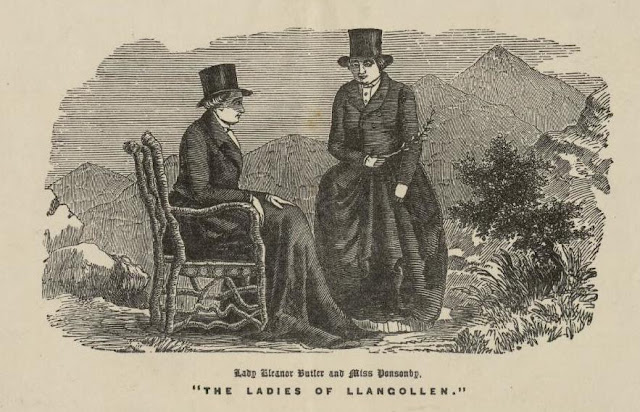 |
| Wikimedia Commons |
Eleanor was born on May 11, 1739, Sarah, in 1755. Sarah was an orphan raised by her father’s cousins, Sir William and Lady Betty Fownes. She lived with them in Woodstock, County Kilkenny, Ireland. She had to suffer the unwanted attentions afforded to her by Sir William, whose wife’s failing health had him eagerly anticipating for the day when Sarah could take Betty’s place and become the second Lady Fownes.
Eleanor resided 15 miles from where Sarah lived. She was the youngest daughter of the Earl of Ormonde of Kilkenny Castle. She was educated in a convent in France, thus she spoke French. She was considered by her family as an over-educated bookworm.
 |
| Plas Newydd |
Eleanor and Sarah first met in 1768 and quickly became close, a relationship fostered by their mutual love for novels such Sarah Scott’s “Millennium Hall” and Samuel Richardson’s “Clarissa”, long walks, as well as French philosophy. Over the succeeding years, they devised a plan to realize their dream of retiring together, abandoning the fashionable society in exchange of a life focused on self-improvement activities, which include sketching, reading, learning new languages, gardening, and doing charitable works.
On the night of March 30, 1778, while everyone was asleep, Sarah, together with her little dog Frisk, slipped out of their Georgian mansion’s window all while dressed in men’s clothing with a pistol in her hand. She then met Eleanor, who was wearing breeches and a topcoat, at the estate’s barn. They were supposed to catch the ferry at Waterford, however it did not sail that night, forcing them to take shelter in the barn, where they were eventually caught and taken home.
Sarah fell ill for staying the night in the barn, while Eleanor was incarcerated in a French convent. The former warned her guardians that if she was not allowed to “live and die with Miss Butler”, it would “provoke her to an act that would give her friends more trouble than anything she had yet done”. The latter, on the one hand, ran away from the convent and hid in Sarah’s bedroom. A housemaid, Mary Carryll, would smuggle food for her.
The ladies’ determination to live together eventually worn down their families, with Lady Betty being comforted by the fact that at least “there was no man concerned with either of them”. Sarah and Eleanor were allowed to leave Ireland. They were provided with a coach that took them to the seaport, and was accompanied by Butler housemaid Mary Carryll, who would live and work for them without pay for the rest of her life.
Sarah and Eleanor toured the Wales countryside before they settled in North Wales. In 1780, they finally resided at a simple abode in the Vale of Llangolen, a five-roomed stone cottage with windows that resembled that of a child’s symmetrical drawing.
 |
| Wikimedia Commons |
The two ladies made major alterations to their Llangolen house, which they named Plas Newydd or “New Mansion”. The windows were Gothicized, embellished with old stained glass panels. The interior was decorated with wood panels and carvings as the two developed a penchant for old carved wood, which they obtained from broken Elizabethan and Jacobean furniture, medieval churches, or abandoned grand mansions. The grounds became as elaborate as the house itself as acres of land were added as years passed. Peach trees, nectarines, melons, and 40 varieties of rose flourished at their residence.
Their unconventional ways attracted numerous notable personalities who would stop by Plas Newydd while traveling between Dublin and London. Their guests included poets William Woodsworth, Sir Walter Scott, Robert Southey, Percy Shelley, Lord Byron, and Anna Seward, as well as Prince Hermann Ludwig Heinrich von Pückler-Muskauof Germany, English industrialist Josiah Wedgewood, Anglo-Irish aristocrat and novelist Caroline Lamb, and Anglo-Irish military leader Arthur Wellesley, 1st Duke of Wellington. So famous were they that Sarah and Eleanor were credited to have inspired English diarist Anne Lister to informally marry her own lover.
Sarah and Eleanor only lived on state pensions and family allowances, but they never learned to manage their small income. They would often be in huge debt due to their expensive ways. They kept several servants, hosted an array of guests, drank only the best wine, and modified their house almost endlessly. Their glassware and books bore both of their initials, and they would jointly sign their letters.
 |
| Wikimedia Commons |
During the latter part of their lives, both ladies wore black riding habits and men’s top hats. They were rumored to have been in a sexual relationship, however nothing in their extensive diaries or correspondence could indicate such. Some claim that Sarah and Eleanor had a nonsexual romantic friendship, while others considered the ladies’ relationship as a Boston marriage, a romantic relationship between two women who chose to live together and have a marriage-like relationship.
Professor Fiona Brideoake deems it more appropriate to describe Sarah and Eleanor as queers rather than lesbians, which is a specific and anachronistic label. Sarah and Eleanor were the subjects of William Woodsworth’s sonnet, "To the Lady E.B and the Hon. Miss P". Anna Seward associated Sarah and Eleanor with “chaste provinciality” in her 1796 poem, “Llangollen Vale”. Mary Carryll died on November 22, 1809. Eleanor passed away on June 2, 1829, and Sarah, two years later, on December 9, 1831. All three of them were laid to rest at at St Collen's Church in Llangollen.

.png)





0 Comments